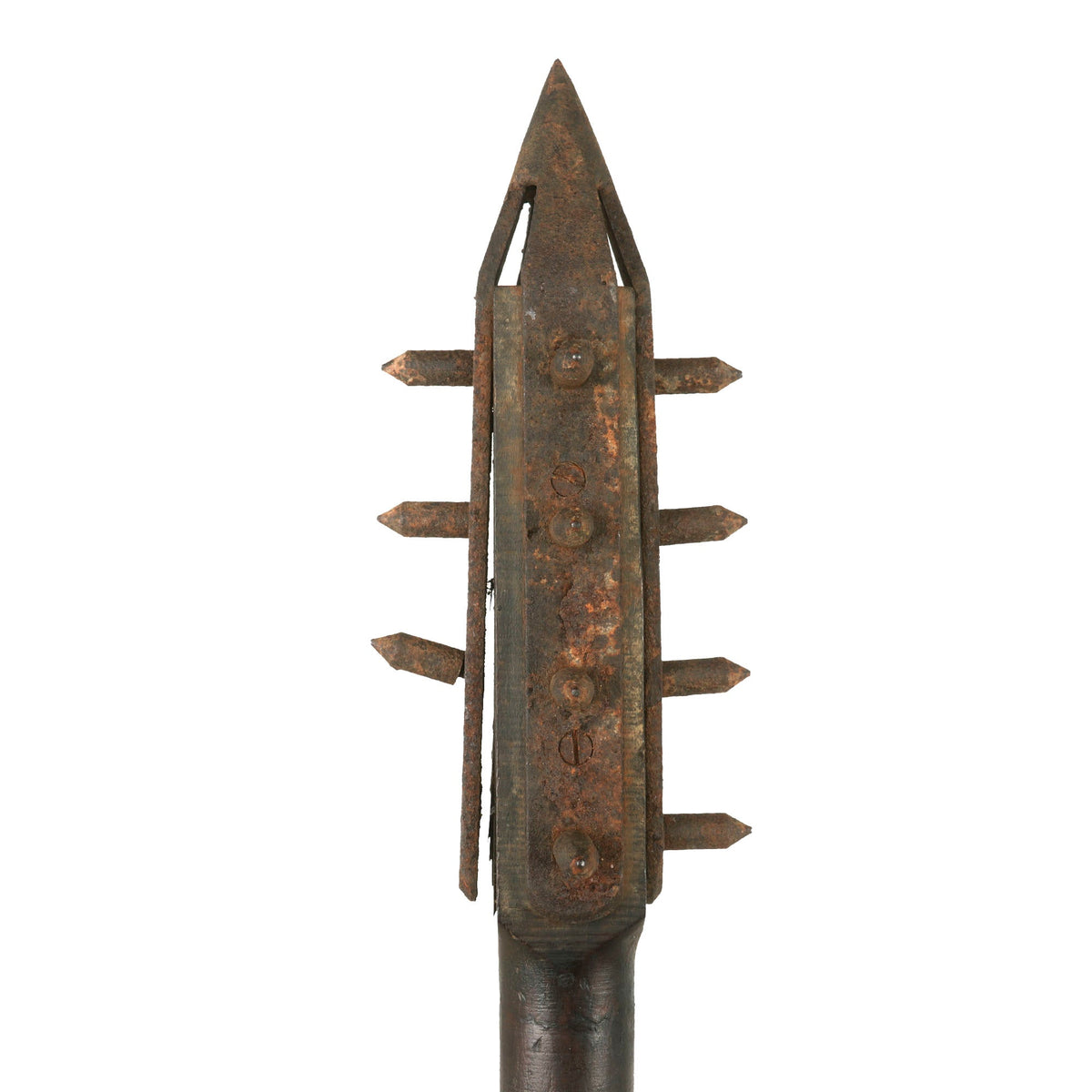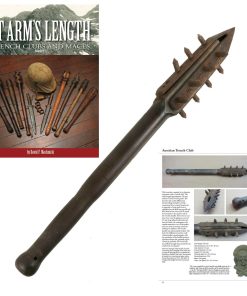Original Austro-Hungarian WWI Rastremato Model Trench Raiding Club – Featured in “At Arms Length: Trench Clubs and Knives” by David F. Machnicki Original Items
$ 3.495,00 $ 873,75
Original Item. One-of-a-Kind. Purchased directly from David F. Machnicki, the author of At Arm’s Length Trench Clubs and Knives (Vol. 1), where this very club is featured on page 11! Please note that the attached page image from the book is copyrighted material and the use of the page is done by permission of the author. A printed copy of the page will accompany the purchase of this club. This is one of the greatest examples of a WWI Trench Club we have ever offered, as it was originally discovered in the mountains of Italy, and is therefore a completely genuine and certainly combat-utilized example.
This example of an Austrian trench club illustrates a radically different approach to the design for a club than those typically encountered. And due to its tapered profile, this type of club has been identified in current references as the rastremato model (Italian: rastremato – tapered). Unlike a similar rastremato model we had from this same book, this example differs in being made from a metal framework as opposed to a cylindrical metal shell. Metal screws were used to attach its iron head to the anterior end of the wooden handle.
The trench club measures in total, 23.425 inches, or 595mm. The head measures 231mm or roughly 9 inches, with the spikes each measuring 25mm each, or just shy of an inch each.
An example of this model of trench club is on display at a Museum at Pasubio Pass, Italy. The museum is located in a mountainous region where during the Summer of 1917, the Battle of Ortigara was fought between Austria & Italy. From this, we can identify this model as having been extensively used in the mountainous Alpine regions where the Austro-Hungarians & Italians fought during World War I.
This example was in fact found in the mountainous regions of Italy, and originally came to us with the handle split in half. But after some skilled work by our master restorer, we have fully repaired the club as shown. At some point in its life, the club also lost two of its sixteen (16) 25mm long spikes which are firmly anchored into the frame.
The anterior end of this handle is quadrangular, with the remainder of the handle having a cylindrical shape that gradually tapers towards its pommel. A 6mm hole was drilled through the pommel for the attachment of a lanyard, which is now absent. As shown, there is a bit of wood loss to the handle under the wood frame, but this damage doesn’t show any danger or risk of breakage anytime soon. This is a very solid trench club that we have repaired the handle of, only further strengthening it.
This is one of the greatest examples of a WWI Trench Raiding club we have ever offered, and its excavation only solidifying its provenance as a combat-utilized weapon. Don’t miss out! Comes ready for further research and display!
Total length: 23.425 inches (595 mm)
Head dimensions: 231 x 98 x 98 mm
Grip diameter: 31 mm
Pommel diameter: 37 mm
Lanyard: 6.0 mm hole
Terminal spike: 62 x 35 x 35 mm
Mass: 3.005 lbs (1363 grams)
Other: (14 spikes) 25 x 10 x 10 mm
Trench raiding clubs were homemade melee weapons used by both the Allies and the Central Powers during World War I. Clubs were used during nighttime trench raiding expeditions as a quiet and effective way of killing or wounding enemy soldiers. The clubs were usually made out of wood. It was common practice to fix a metal object at the striking end (e.g. an empty Mills bomb) in order to maximize the injury inflicted. Another common design comprised a simple stave with the end drilled out and a lead weight inserted, with rows of large hobnails hammered in around its circumference. Most designs had some form of cord or leather strap at the end to wrap around the user’s wrist. Bosnian soldiers serving in the Austro-Hungarian army were fond of using maces. They were also used by officers to finish enemy soldiers wounded by poison gas attacks.
Trench clubs were manufactured in bulk by units based behind the lines. Typically, regimental carpenters and metal workers would make large numbers of the same design of club. They were generally used along with other “quiet” weapons such as trench knives, entrenching tools, bayonets, hatchets and pickaxe handles – backed up with revolvers and hand grenades.
Fast Shipping with Professional Packaging
Thanks to our longstanding association with UPS FedEx DHL, and other major international carriers, we are able to provide a range of shipping options. Our warehouse staff is expertly trained and will wrap your products according to our exact and precise specifications. Prior to shipping, your goods will be thoroughly examined and securely secured. We ship to thousands clients each day across multiple countries. This shows how we're dedicated to be the largest retailer on the internet. Warehouses and distribution centres can be located throughout Europe as well as the USA.
Note: Orders with more than one item will be assigned a processing date depending on the item.
Before shipping before shipping, we'll conduct a thorough inspection of the items you have ordered. Today, the majority of orders will be delivered within 48 hours. The delivery time will be between 3-7 days.
Returns
The stock is dynamic and we cannot completely manage it because multiple stakeholders are involved, including our factory and warehouse. So the actual stock may alter at any time. It's possible that you may not receive your order once the order has been made.
Our policy is valid for a period of 30 days. If you don't receive the product within 30 days, we are not able to issue a refund or an exchange.
You can only return an item if it is unused and in the same state as the day you received it. You must have the item in its original packaging.
Related products
Uncategorized
Uncategorized
Uncategorized
Uncategorized
Uncategorized
Uncategorized
Uncategorized
Uncategorized
Uncategorized
Uncategorized
Armoured Fighting Vehicles of the World: AFVs of World War One (Hardcover Book) New Made Items
Uncategorized
Uncategorized
Armored Burgonet Helmet & Polearm from Scottish Castle Leith Hall Circa 1700 Original Items
Uncategorized
Australian WWII Owen MK1 Machine Carbine SMG Custom Fabricated Replica with Sling Original Items
Uncategorized
Uncategorized
Uncategorized
Uncategorized
Band of Brothers ORIGINAL GERMAN WWII Le. F.H. 18 10.5cm ARTILLERY PIECE Original Items
Uncategorized
Uncategorized












































































